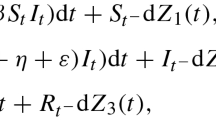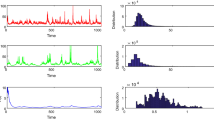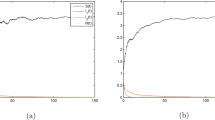Abstract
In this work, we present analysis of a SIR model where white noises, telegraph noises (Markov switching) and Lévy jumps serve as sources of environmental perturbations in the system. Based on the Feller property, we derive sufficient conditions for the existence of a unique stationary distribution with ergodic property using the mutually exclusive probabilities technique (Stenner in the existence and uniqueness of invariant measure for continuous-time Markov process, Tech. Report, pp 18-86, Brown University, Providence, RI, USA, 1986). Further, in a special case, we derived condition for disease eradication. Using numerical simulations, we were able to illustrate the analytical results obtained herein. Some of the results reveal that, in a Markovian switching regime, white noises and Lévy jumps could determine whether the disease is eradicated or not, with both sources of random perturbations affecting the degree of disease persistence.















Similar content being viewed by others
Availability of data and material
No specific data or unique material was used for this work.
References
Lou Y, Zhao X-Q (2010) A climate-based malaria transmission model with structured vector population. J SIAM Appl Math 70:2023–2044
Omame A, Okuonghae D, Umana RA, Inyama SC (2020) Analysis of a co-infection model for HPV-TB. Appl Math Model 77:881–901
Omame A, Umana RA, Okuonghae D, Inyama SC (2018) Mathematical analysis of a two-sex human papillomavirus (HPV) model. Int J Biomath 11(7):1850092
Kermack WO, McKendrick AG (1927) Contributions to the mathematical theory of epidemics, part 1. Proc R Soc Lond Ser A 115:700–721
Khan T, Khan A, Zaman G (2018) The extinction and persistence of the stochastic Hepatitis B epidemic model. Chaos Solitons Fractals 108(8):123–128
van den Driessche P, Watmough J (2002) Reproduction numbers and sub-threshold endemic equilibria for compartmental models of disease transmission. Math Biosci 180:29–48
Liu Q, Jiang D (2019) The dynamics of a stochastic vaccinated tuberculosis model with treatment. Phys A 527:121274
Ge J, Zuo W, Jiang D (2022) Stationary distribution and density function analysis of a stochastic epidemic HBV model. Math Comput Simul 191:232–255
Liu Q, Jiang D, Hayat T, Alsaedi A (2018) Dynamics of a stochastic tuberculosis model with antibiotic resistance. Chaos Solitons Fractals 109:223–230
Miao A, Zhang J, Zhang T, Pradeep BGSA (2017) Threshold dynamics of a stochastic SIR model with vertical transmission and vaccination. Comput Math Methods Med 4820183. https://doi.org/10.1155/2017/4820183
Okuonghae D (2021) Analysis of a stochastic mathematical model for tuberculosis with case detection. Int J Dyn Control. https://doi.org/10.1007/s40435-021-00863-8
Zhao Y, Jiang D (2014) The threshold of a stochastic SIS epidemic model with vaccination. Appl Math Comput 243:718–727
Kiouach D, Sabbar Y (2020) Ergodic stationary distribution of a stochastic Hepatitis B epidemic model with interval-valued parameters and compensated Poisson process. Comput Math Models Med. https://doi.org/10.1155/2020/9676501
Zhou Y, Zhang W (2016) Threshold of a stochastic SIR epidemic model with Lévy jumps. Phys A 446:204–216
Zhang X, Wang K (2013) Stochastic SIR model with jumps. Appl Math Lett 26:867–874
Liu M, Zhu Y (2018) Stationary distribution and ergodicity of a stochastic hybrid competition model with Lévy jumps. Nonlinear Anal Hybrid Syst 30:225–239
Yu J, Liu M (2017) Stationary distribution and ergodicity of a stochastic food-chain model with Lévy jumps. Phys A 482:14–28
Cao Z, Liu X, Wen X, Liu L, Zu L (2019) A regime-switching SIR epidemic model with a ratio-dependent incidence rate and degenerate diffusion. Sci Rep 9:10696
Settati A, Lahrouz A (2014) Stationary distribution of stochastic population systems under regime switching. Appl Math Comput 244:235–243
Zhou Y, Zuo W, Jiang D, Song M (2020) Stationary distribution and extinction of a stochastic model of syphilis transmission in an MSM population with telegraph noises. J Appl Math Comput. https://doi.org/10.1007/s12190-020-01453-1
Stenner L (1986) On the existence and uniqueness of invariant measure for continuous-time markov process, Tech. Report, pp 18–86, Brown University, Providence, RI, USA
Zhao D, Yuan S (2018) Sharp conditions for the existence of a stationary distribution in one classical stochastic chemostat. Appl Math Comput 339:199–205
Khasminskii R (1980) Stochastic stability of differential equations. Sijthoff and Noordhoff, The Netherlands
Mao X (1997) Stochastic differential equations and applications. Horwood Publishing, Chichester
Sene N (2020) Analysis of the stochastic model for predicting the novel coronavirus disease. Adv Differ Equ. https://doi.org/10.1186/s13662-020-03025-w
Meyn SP, Tweedie RI (1993) Stability of markovian processes III: Foster–Lyapunov criteria for continuous-time process. Adv Appl Probab 25:518–548
Tong J, Zhang Z, Bao J (2013) The stationary distribution of the facultative population model with a degenerate noise. Statist Probab Lett 83:655–664
Higham DJ (2001) An algorithmic introduction to numerical simulation of stochastic differential equations. SIAM Rev 43(1):525–546
Acknowledgements
We are grateful to the anonymous reviewers for their insightful comments which have improved the quality of this work.
Funding
This work was carried out without any funding.
Author information
Authors and Affiliations
Contributions
The work was 100% carried out by the author.
Corresponding author
Ethics declarations
Conflict of interest
The author declares that there is no conflict of interest regarding the publication of this paper.
Code availability
The codes used for the simulations in this work may be made available on request.
Appendices
Appendix A: Proof to Lemma 2.1
Proof
Let \(\phi (t)\) be the solution of
with \(\phi (0) = 1\). Using the generalized Itô’s formula to \(\ln \phi (t)\) and taking integrations, we have that
Applying the variation-of-constants formula, we have that \(\theta (t) = \theta (0)f(t)+\Lambda (k)f(t)\int _0^t f^{-1}(s)\mathrm{d}s\), where
Then,
where
Since, based on the results in [14], we have that
it is easy to get the desired result that
Appendix B: Proof to Lemma 2.2
Proof
Applying Itô’s formula to the addition of the first two equations in (1.2), we have that
Now,
Integrating (5.2), we have that
Taking expectations, we have that
Now, we have that
\(\square \) .
Rights and permissions
About this article
Cite this article
Okuonghae, D. Ergodic stationary distribution and disease eradication in a stochastic SIR model with telegraph noises and Lévy jumps. Int. J. Dynam. Control 10, 1778–1793 (2022). https://doi.org/10.1007/s40435-022-00962-0
Received:
Revised:
Accepted:
Published:
Issue Date:
DOI: https://doi.org/10.1007/s40435-022-00962-0




